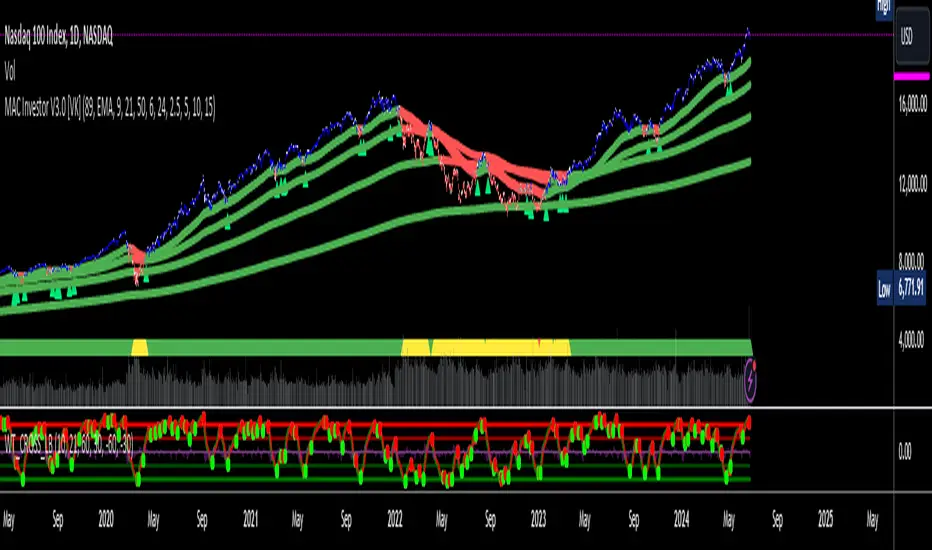OPEN-SOURCE SCRIPT
업데이트됨 MAC Investor V3.0 [VK]

This indicator combines multiple functionalities to assist traders in making informed decisions. It primarily uses Heikin Ashi candles, Moving Averages, and a Price Action Channel (PAC) to provide signals for entering and exiting trades. Here's a detailed breakdown:
Inputs
Calculations and Features
Use Cases and How to Use
Maximizing Profit
To maximize profit with this indicator:
How to Use the Indicator
Inputs
- MAC Length: Sets the length for the PAC calculation.
- Use Heikin Ashi Candles: Option to use Heikin Ashi candles for calculations.
- Show Coloured Bars around MAC: Option to color bars based on their relation to the PAC.
- Show Long/Short Signals: Options to display long and short signals.
- Show MAs?: Option to show moving averages on the chart.
- Show MAs Trend at the Bottom?: Option to show trend signals at the bottom of the chart.
- MA Lengths: Length settings for three different moving averages.
- Change MA Color Based on Direction?: Option to change the color of moving averages based on trend direction.
- MA Higher TimeFrame: Allows setting a higher timeframe for moving averages.
- Show SL-TP Lines: Option to display Stop Loss and Take Profit lines.
- SL/TP Percentages: Set the percentages for Stop Loss and three levels of Take Profit.
Calculations and Features
- Heikin Ashi Candles: Calculations are based on Heikin Ashi candle data if selected.
- Price Action Channel (PAC): Uses Exponential Moving Averages (EMA) of the high, low, and close to create a channel.
- Bar Coloring: Colors the bars based on their position relative to the PAC.
- Long and Short Signals: Uses crossovers of the close price and PAC upper/lower bands to generate signals.
- Moving Averages (MA): Plots three moving averages and colors them based on their trend direction.
- Overall Trend Indicators: Uses triangles at the bottom of the chart to show the overall trend of the MAs.
- Stop Loss and Take Profit Levels: Calculates and plots these levels based on user-defined percentages from the entry price.
- Alerts: Provides alerts for long and short signals.
Use Cases and How to Use
- Identifying Trends: The PAC helps to identify the trend direction. If the closing price is above the PAC upper band, it suggests an uptrend; if below the lower band, it suggests a downtrend.
- Entering Trades: Use the long and short signals to enter trades. A long signal is generated when the closing price crosses above the PAC upper band, and a short signal is generated when it crosses below the PAC lower band.
- Exit Strategies: Utilize the Stop Loss (SL) and Take Profit (TP) levels to manage risk and lock in profits. These levels are automatically calculated based on the entry price and user-defined percentages.
- Trend Confirmation with MAs: The moving averages provide additional confirmation of the trend. When all three MAs are trending in the same direction (e.g., all green for an uptrend), it adds confidence to the trade signal.
- Overall Trend Indicators: The triangles at the bottom of the chart show the overall trend direction of the MAs:
- Green Triangle: All three MAs are trending upwards, indicating a strong uptrend.
- Red Triangle: All three MAs are trending downwards, indicating a strong downtrend.
- Yellow Triangle: Mixed signals from the MAs, indicating no clear trend.
- Bar Coloring for Quick Analysis: The colored bars give a quick visual cue about the market condition, aiding in faster decision-making.
- Alerts: Set up alerts to get notified when a long or short signal is generated, allowing you to act promptly without constantly monitoring the chart.
Maximizing Profit
To maximize profit with this indicator:
- Follow the Signals: Use the long and short signals to time your entries. Ensure you follow the trend indicated by the PAC and MAs.
- Risk Management: Always set your Stop Loss and Take Profit levels to manage risk. This will help you cut losses early and secure profits.
- Confirm with MAs: Look for confirmation from the moving averages. When all MAs align with the signal, it indicates a stronger trend.
- Overall Trend Indicators: Pay attention to the triangles at the bottom for overall trend confirmation. Only enter trades when the overall trend is in your favor.
- Heikin Ashi for Smoothing: Use Heikin Ashi candles for smoother trends and fewer false signals.
- Backtesting: Test the indicator on historical data to understand its performance and adjust settings as necessary.
- Adapt to Market Conditions: Adjust the lengths of PAC and MAs based on the market's volatility and timeframe you are trading on.
How to Use the Indicator
- Add to Chart: Add the indicator to your TradingView chart.
- Configure Settings: Customize the input settings to fit your trading strategy and timeframe.
- Monitor Signals: Watch for long and short signals and observe the trend direction with the PAC and MAs.
- Check Overall Trend: Look at the triangles at the bottom of the chart to see the overall trend direction of the MAs.
- Set Alerts: Configure alerts to get notified of new signals.
- Manage Trades: Use the SL and TP levels to manage your trades effectively.
릴리즈 노트
Minor fix오픈 소스 스크립트
트레이딩뷰의 진정한 정신에 따라, 이 스크립트의 작성자는 이를 오픈소스로 공개하여 트레이더들이 기능을 검토하고 검증할 수 있도록 했습니다. 작성자에게 찬사를 보냅니다! 이 코드는 무료로 사용할 수 있지만, 코드를 재게시하는 경우 하우스 룰이 적용된다는 점을 기억하세요.
면책사항
해당 정보와 게시물은 금융, 투자, 트레이딩 또는 기타 유형의 조언이나 권장 사항으로 간주되지 않으며, 트레이딩뷰에서 제공하거나 보증하는 것이 아닙니다. 자세한 내용은 이용 약관을 참조하세요.
오픈 소스 스크립트
트레이딩뷰의 진정한 정신에 따라, 이 스크립트의 작성자는 이를 오픈소스로 공개하여 트레이더들이 기능을 검토하고 검증할 수 있도록 했습니다. 작성자에게 찬사를 보냅니다! 이 코드는 무료로 사용할 수 있지만, 코드를 재게시하는 경우 하우스 룰이 적용된다는 점을 기억하세요.
면책사항
해당 정보와 게시물은 금융, 투자, 트레이딩 또는 기타 유형의 조언이나 권장 사항으로 간주되지 않으며, 트레이딩뷰에서 제공하거나 보증하는 것이 아닙니다. 자세한 내용은 이용 약관을 참조하세요.